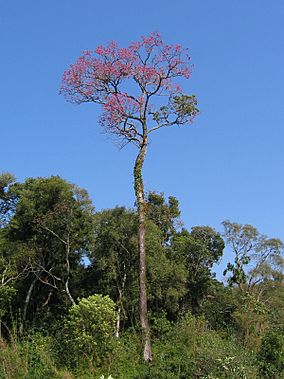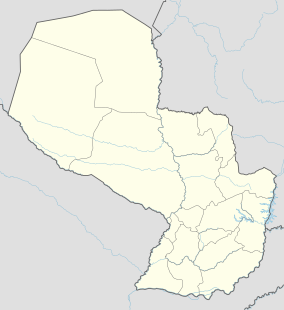San Rafael National Park facts for kids
Quick facts for kids San Rafael National Park |
|
|---|---|
| Parque Nacional San Rafael | |
|
IUCN Category II (National Park)
|
|

Handroanthus impetiginosus in the San Rafael Reserve
|
|
| Nearest city | Itapúa Department, Paraguay |
| Area | 69,304 hectares (171,250 acres) |
| Designation | National park |
| Created | 1992 |
| Administrator | none |
The San Rafael National Park (in Spanish: Parque Nacional San Rafael) is a special place in Paraguay. It's meant to be a national park and is home to amazing Atlantic Forests, open grasslands, and wet areas called wetlands. Even though people decided it should be a national park way back in 1992, it hasn't officially become one yet. This area is facing challenges from big farms and smaller farms that clear land by burning it.
Contents
Where is San Rafael National Park?
The San Rafael National Park is located in two different parts of Paraguay: the Itapúa and Caazapá areas. It covers a huge space of about 69,304 hectares. To give you an idea, one hectare is about the size of a football field!
This park is found near the top of the Tebicuary River basin, in a hilly area called the San Rafael hills. The land here goes from about 100 meters (328 feet) to 500 meters (1,640 feet) above sea level. This park is also planned to be part of a bigger project called the Trinational Biodiversity Corridor. This corridor aims to connect forests in Brazil, Paraguay, and Argentina, helping animals move safely between different protected areas.
Why is the Park's Status Unclear?
In 1992, the San Rafael area was set aside as an "Area Reserved for a National Park." It was supposed to be about 78,000 hectares. However, all the land in this area is owned by private people, not the government. This has caused some disagreements about making it a park.
In 2002, the area's status was changed to a "managed resources reserve." This means people can use the land's resources in a careful way, but it's not as strictly protected as a national park. Luckily, this change was reversed in 2005. So, the area is still waiting to be officially declared either a full national park or a managed resources reserve.
A group called Guyra Paraguay, which is a non-profit organization, has bought about 6,500 hectares of land inside the park. They manage this land as a protected area, helping to keep it safe for nature.
What is the Environment Like?
The weather in San Rafael National Park is warm. Temperatures usually range from 17 to 23.8 degrees Celsius (62.6 to 74.8 degrees Fahrenheit). The hottest time is from October to April, and the coolest is from May to September.
This area gets a lot of rain, about 2,100 millimeters (82 inches) each year. Rain falls throughout the year, but the wettest months are from October to February.
Forests and Grasslands
The park is mostly covered by a special type of forest called the Alto Paraná Lowland Atlantic Forest. This forest is part of the larger Atlantic Forest biome, which is a very important and threatened natural area. San Rafael is in a unique spot where tall, wet forests from the Paraná River basin meet drier forests from the Paraguay River basin. About 80% of the park is covered by these forests.
Besides forests, the park also has large areas of natural grasslands and wetlands. These are found in the northern part of Paraguay's central grasslands.
Amazing Animals of San Rafael
San Rafael National Park is home to many incredible animals.
- Mammals: You might find big cats like the jaguar (Panthera onca) and the South American tapir (Tapirus terrestris). There are four types of large mammals in the park that are considered globally threatened, meaning they are at risk of disappearing from the world.
- Birds: This park is a birdwatcher's paradise! Over 400 different kinds of birds have been seen here, which is more than any other place in Paraguay. Twelve of these bird species are globally threatened. Some of these special birds include the vinaceous-breasted amazon (Amazona vinacea) and the black-fronted piping guan (Pipile jacutinga). The park also has important groups of birds like the helmeted woodpecker (Celeus galeatus), russet-winged spadebill (Platyrinchus leucoryphus), cock-tailed tyrant (Alectrurus tricolor), and saffron-cowled blackbird (Xanthopsar flavus).
What Threats Does the Park Face?
Even though San Rafael is a protected area, it faces several challenges. As of 2016, there wasn't a good plan in place to manage the forests effectively. The soil in the park is very rich, which means there's a lot of pressure to turn the land into farms, especially for growing soya beans.
Since 1989, parts of the forest have been steadily cleared, and grasslands have been changed into areas for grazing animals or for farming. By 2007, more than 22% of the original park area had been greatly changed. The region is threatened by large-scale farming, by farmers who clear land by burning it (which isn't good for the environment in the long run), and by fires. Sadly, only a small connection now remains between San Rafael and the nearby Caazapá National Park.
Images for kids
See also
In Spanish: Parque nacional San Rafael para niños



